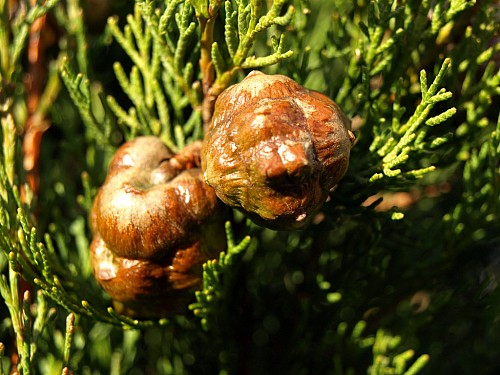Tree Disease Treatment for the Amateur Arborist
Are your trees looking less than their best? They may be suffering from some form of tree disease or insect infestation. Here is a guide to common tree problems, with suggestions for (mostly) DIY treatment and prevention.
Disease
Canker. Canker is a fungus that appears as lesions or dead areas on branches, after injury or stress (like frost cracks or lawn mower impact). Canker is often lethal to young trees if not treated promptly. TREATMENT: wrapping young trees against severe weather, watering during droughts.
Fire blight. Blackened, “burnt” looking leaves and flowers that dry up and droop indicate fire blight. TREATMENT: pruning branches at least 12 inches past the discolored area, discontinuation of nitrogen-rich fertilizer or compost.
Gall. Watch out for swollen tumor-like growths on tree trunk, shoots, or leaves, suggesting a gall infection. Unfortunately, gall is difficult for an amateur to treat, because there are many possible causes. TREATMENT: professional arborist consultation.
Leaf rust. Rusty splotches colored yellow, orange, red, or brown point to a case of leaf rust. This fungus rarely causes serious damage, but it’s ugly. TREATMENT: autumn pruning, fungicide application.
Leaf spot. Leaf spot may be identified as red spots on leaves, which turn into rotten holes. This fungus may cause major loss of leaves. TREATMENT: pruning and removal of diseased leaves.
Powdery mildew. A thin white or grayish powdering on your tree’s leaves is symptomatic of powdery mildew. TREATMENT: selection of mildew-resistant saplings for new planting, fungicide application.
Witches’ broom. Usually growth is a good thing, except when your tree starts sprouting prolific broom-shaped clusters of shoots. The tree disease called witches’ broom can be deadly. TREATMENT: pruning of brooms, fungicide in early spring or autumn.
Infestation
Eastern tent caterpillar. Eastern tent caterpillar infestation is easy to detect – in spring, silky webs up to 12” appear in branch crotches. The hungry caterpillars can defoliate and then kill young trees. TREATMENT: web removal with a pole, shaking the caterpillars into soapy water, systemic pesticide.
Emerald ash borer. A thinning crown, D-shaped holes in the bark, uneven branch growth, and the presence of woodpeckers are signs your ash tree may be infested with emerald ash borers. TREATMENT: systemic insecticide applied to tree roots in spring or fall.
Japanese beetle. Spot a few greenish beetles with coppery wing cover, as well as lace-like tree leaves which appear to have been nibbled (they have!), and we’re talking Japanese beetles. TREATMENT: knocking larvae and adults into soapy water, soil insecticide.
Scale. Insect infestation, not tree disease, is probably the culprit when your tree becomes covered with hardened “honeydew” bumps, especially if ants, bees, and flies wasps flock around. Scale could eventually kill your tree if ignored. TREATMENT: early identification of scale variety, horticultural oil or systemic insecticide. For fruit trees, use only food-safe products.
Spider mite. Spider mites (arachnids, like spiders) are detectable by the fine silk webbing formed on leaves. Tiny mites are capable of stunting or even killing a young tree. TREATMENT: spraying with miticidal oil or soap, release of predatory insects like ladybugs.
Prevention
Choose saplings carefully. Purchase trees from a reputable landscaper, selecting firm specimens that are not discolored or root-bound. Ensure they are disease-resistant species suitable for your climate.
Water young trees regularly. Usually, trees over 2 years have a mature enough root system to obtain water from the ground. However, in a drought, you’ll need to supplement their water supply.
Feed. See whether trees will need supplements via a soil test, either DIY (kits should be available through your local university extension program) or professional. Add compost or fertilizer appropriate for your property’s soil type.
Mulch. Spreading a layer of mulch (such as grass clippings or wood chips) around the base of a tree offers many benefits – moisture retention, weed prevention, and protecting roots against soil temperature fluctuations.
Prune. Careful tree trimming will help keep your mini forest in good health.
Inspect. Check regularly for signs of tree disease or infestation. Treat problems promptly, before they cause serious damage or spread to other trees nearby.
Avoid spreading tree disease. Don’t compost leaves or limbs after trimming diseased or infested trees. Dispose of the waste by burning (if permitted in your locale), burying far from your garden, or sealing in a plastic garbage bag for trash collection. Disinfect pruning tools.
Laura Firszt writes for networx.com.
Updated December 23, 2018.
Looking for a Pro? Call us (866) 441-6648

Average Costs
Related Experiences

Careful, Professional Tree Service Removes A Huge Norway Maple

I Built A Concrete Retaining Wall As A Defense Against El Nino




